Archives
-
Meine Top-3 Entwicklertools
Die Chance, eine XBox zu gewinnen, lasse ich mir natürlich nicht entgehen, daher hier meine persönliche Top-3 Liste der Entwicklertools:
- JetBrains ReSharper hat es mit gewissen Anlaufschwierigkeiten (Tests von früheren Versionen hinterließen bei mir z.T. einen zwiespältigen Eindruck) nun in der Version 4.5 auf Anhieb in die Top-3 geschafft.
- .NET Reflector braucht man einfach immer wieder, sollte daher auf jeder Entwickler-Maschine installiert sein.
- SonicFileFinder dient zum schnellen Suchen von Dateien in Visual Studio und schlägt dabei die in ReSharper eingebaute Funktionalität.
Erwähnenswert ist natürlich Visual Studio, das aber nicht in der Top-3 Liste ist, weil man es für Entwickler eigentlich schon zum Betriebssystem zählen kann ;-)
- JetBrains ReSharper hat es mit gewissen Anlaufschwierigkeiten (Tests von früheren Versionen hinterließen bei mir z.T. einen zwiespältigen Eindruck) nun in der Version 4.5 auf Anhieb in die Top-3 geschafft.
-
Das war die dotnet Cologne 2009
Ein erstaunlich reibungsloser Ablauf, sehr positives Feedback von Teilnehmern, Sprechern und Sponsoren – alles in allem war die dotnet Cologne 2009, eine Community-Konferenz für WPF und Silverlight, für mich als Co-Organisator zwar eine anstrengende, aber auch sehr befriedigende Angelegenheit.
Die Konferenz war eine Gemeinschaftsproduktion der von Albert Weinert geleiteten .net user group Köln und der von mir geleiteten Bonner Gruppe Bonn-to-Code.Net, die im Januar zu diesem Zweck den dotnet Köln/Bonn e.V. gegründet hatten, mit Stefan Lange als erstem Vorsitzenden. An dieser Stelle sei auch die Mithilfe von Stefan Lieser und Jan Welker sowie unserer Helfer vor Ort (Janine Gollub, Carla Hein und Alberts Vater) erwähnt. Ein großer Dank gilt natürlich unseren Sprechern und Sponsoren, nicht zuletzt Microsoft mit großartiger Unterstützung. Ein ganzer Tag mit zwei Tracks, 11 Sessions, Freigetränken und einem umfangreichen Mittagessen für nur 15,- Euro wäre ohne sie nicht möglich gewesen.
Es war nur ein wenig schade, dass wir frühzeitig Opfer unseres Erfolgs wurden und für die Anmeldung rund einen Monat vor dem Termin eine Warteliste einrichten mussten. So mussten wir leider vielen Interessenten absagen und für die 160 Teilnehmer vor Ort wurde es hier und da stellenweise etwas “kuschelig”.
Für das nächste Jahr – eine dotnet Cologne 2010 ist bereits fest ins Auge gefasst – werden wir in Bezug auf die Räumlichkeiten unsere Möglichkeiten ausloten, wobei der diesjährige Ort (die Microsoft-Niederlassung am Kölner Rheinufer) in vielerlei Hinsicht schon sehr attraktiv war.
Hier noch ein paar Impressionen:
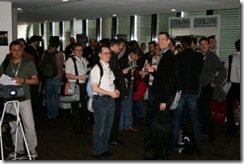
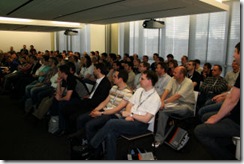
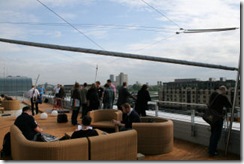
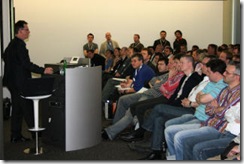
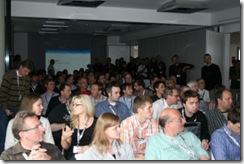
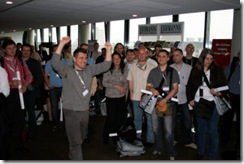
-
Oh No: Windows 7 Start Menu Search Still Different From Vista’s
Edit 2009-05-02: After a bit more fiddling around, things look a bit different now. Edits are inline and at the bottom of this post.
When I tried the Beta of Windows 7 a few months ago, the changed behavior of the Start Menu Search caught my eye immediately:
- Imagine you just installed Paint.NET on your machine
- You press the Windows key, and start typing “paint”.
- The start menu will present you “Paint” (for the Paint.exe that comes with Windows) and “Paint.NET”.
- In Vista, if you choose Paint.NET and start it, the next time you press the Windows key and type “paint”, the entry “Paint.NET” will be at the top. A nice feature, that even my dad picked up immediately. In his case the paint program he wants to start is “Corel Paint Shop Pro”. He doesn’t care about the company name or the exact name of the program – it’s the “paint thingy” he wants to start, and Windows key, “paint”, Enter does the job.
- Windows 7 knows better, though.
Search results are always shown in the same order(Edit: things are a bit more complicated than that. search results are in fact handled like in Vista with the exception of shortcuts pointing to Windows programs. These are always shown at the top of the results. That’s why Paint.Net couldn’t move up in the result list). Maybe it’s about consistency and avoiding mistakes by people who don’t look at the result list before they press Enter. But frankly I don’t care. Giving me a wonderful feature in Windows Vista and taking it away in Windows 7 is plain cruel.
I posted a feedback (see note regarding the link) to the Connect website regarding this, but didn’t get any reaction from Microsoft (not surprising, considering the amount of feedback they must have gotten).
Now I’ve just installed Windows 7 RC and unfortunately the behavior still is different from Vista. So if there isn’t some setting which I didn’t see at first glance to restore the old behavior, if the code was even ripped out or disabled completely, then chances are pretty slim to see the Vista behavior back again (it’s an RC after all). This is so frustrating. Please somebody tell me that there’s a registry hack…
______
Edit 2009-05-01: It may be that you have to be a member of the Connect program to be able to view the feedback when clicking the link.______
Edit 2009-05-02: I’ve now experimented some more with the Start Menu Search. I created 4 shortcuts in the start menu named “Company Product (A)”, “Company Product (B)”, “Company Product (C)” and “Company Product (D)”, with the last pointing to “C:\Windows\Notepad.exe” (the others pointing to programs somewhere below “C:\Program Files”).After typing “product” in the search box, the default order of the entries was D, A, B, C. Entry D took first place because it pointed to Notepad.exe, a Windows program.
Then I started the program with the shortcut ““Company Product (C)” a couple of times and the resulting order of the entries was D, C, A, B. So entry C moved up, but couldn’t beat entry A.
Now comes the strange part: I created a shortcut named “Network” and typed “net” in the search box. The result: Paint.NET at the top of the list (from my previous experiments), then the shortcut I just created, followed by Windows’ “Connect to a Network Projector” and at last position “Network” (the Windows one). Strange. Next I typed “Network” in the search box, chose the Windows Network, and repeated this a couple of times. The result: My own “Network” shortcut still stayed at the top, the “Network” of Windows stayed at last position. There may be certain hidden logic behind this, but for a user it’s way too confusing.